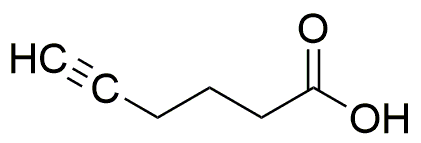5-Hexynoic acid is widely utilized in research focused on various applications:
- Organic Synthesis: This compound serves as a key building block in organic synthesis, particularly for creating complex molecules in pharmaceuticals and agrochemicals.
- Polymer Production: It is used in the production of specialty polymers, enhancing properties such as strength and thermal stability in materials like coatings and adhesives.
- Biochemical Research: Researchers employ 5-Hexynoic acid in biochemical studies to investigate fatty acid metabolism and its effects on cellular processes, contributing to advancements in health sciences.
- Flavor and Fragrance Industry: The compound is explored for its potential use in flavoring agents and fragrances, providing unique sensory profiles that can enhance consumer products.
- Environmental Applications: It is being studied for its role in developing biodegradable materials, addressing environmental concerns by reducing plastic waste.
General Information
Properties
Safety and Regulations
Applications
5-Hexynoic acid is widely utilized in research focused on various applications:
- Organic Synthesis: This compound serves as a key building block in organic synthesis, particularly for creating complex molecules in pharmaceuticals and agrochemicals.
- Polymer Production: It is used in the production of specialty polymers, enhancing properties such as strength and thermal stability in materials like coatings and adhesives.
- Biochemical Research: Researchers employ 5-Hexynoic acid in biochemical studies to investigate fatty acid metabolism and its effects on cellular processes, contributing to advancements in health sciences.
- Flavor and Fragrance Industry: The compound is explored for its potential use in flavoring agents and fragrances, providing unique sensory profiles that can enhance consumer products.
- Environmental Applications: It is being studied for its role in developing biodegradable materials, addressing environmental concerns by reducing plastic waste.
Documents
Safety Data Sheets (SDS)
The SDS provides comprehensive safety information on handling, storage, and disposal of the product.
Product Specification (PS)
The PS provides a comprehensive breakdown of the product’s properties, including chemical composition, physical state, purity, and storage requirements. It also details acceptable quality ranges and the product's intended applications.
Certificates of Analysis (COA)
Search for Certificates of Analysis (COA) by entering the products Lot Number. Lot and Batch Numbers can be found on a product’s label following the words ‘Lot’ or ‘Batch’.
*Catalog Number
*Lot Number
Certificates Of Origin (COO)
This COO confirms the country where the product was manufactured, and also details the materials and components used in it and whether it is derived from natural, synthetic, or other specific sources. This certificate may be required for customs, trade, and regulatory compliance.
*Catalog Number
*Lot Number
Safety Data Sheets (SDS)
The SDS provides comprehensive safety information on handling, storage, and disposal of the product.
DownloadProduct Specification (PS)
The PS provides a comprehensive breakdown of the product’s properties, including chemical composition, physical state, purity, and storage requirements. It also details acceptable quality ranges and the product's intended applications.
DownloadCertificates of Analysis (COA)
Search for Certificates of Analysis (COA) by entering the products Lot Number. Lot and Batch Numbers can be found on a product’s label following the words ‘Lot’ or ‘Batch’.
*Catalog Number
*Lot Number
Certificates Of Origin (COO)
This COO confirms the country where the product was manufactured, and also details the materials and components used in it and whether it is derived from natural, synthetic, or other specific sources. This certificate may be required for customs, trade, and regulatory compliance.

